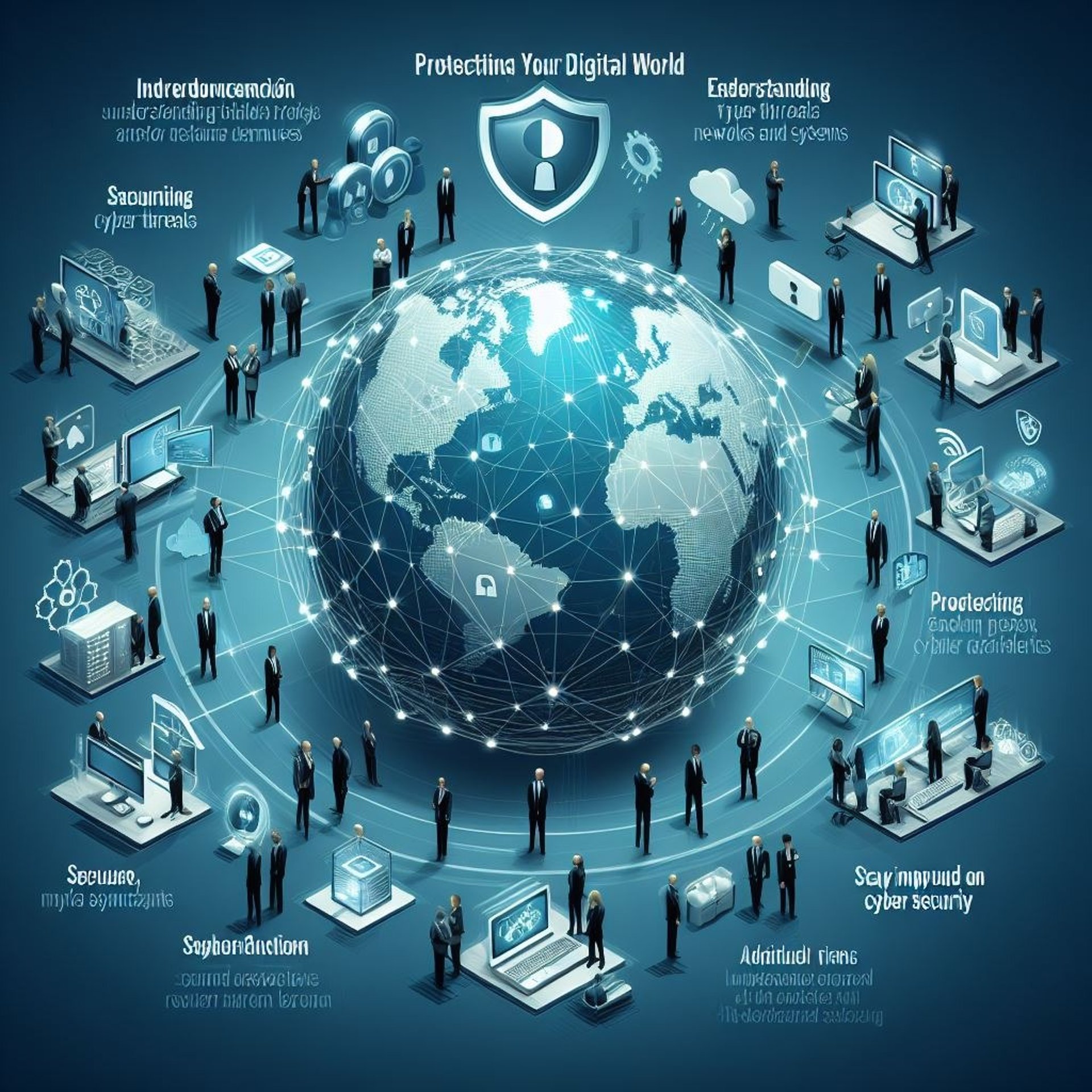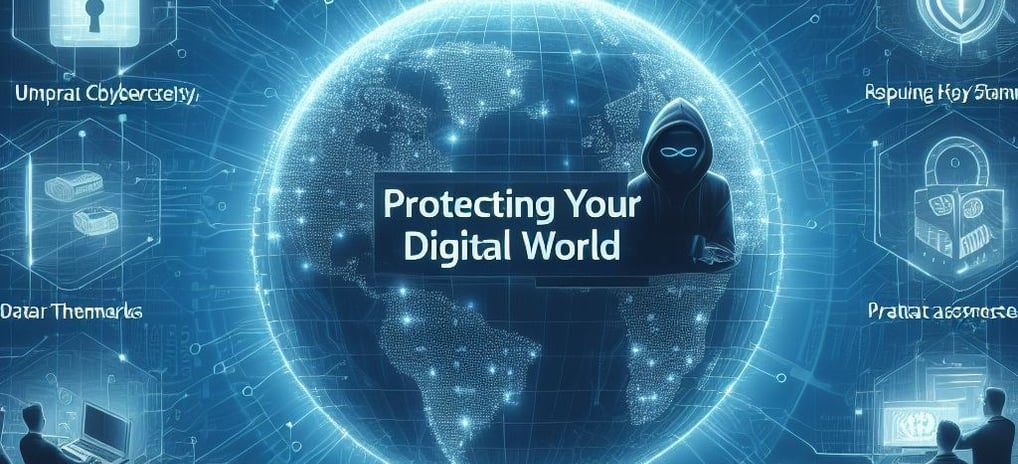
The Ultimate Guide to Cybersecurity: Protecting Your Digital World
This article is a comprehensive, detailed guide to Cyber-Security.
IT SERVICES
4/22/20245 min read



Introduction
In today's digital age, it is more important than ever to prioritize cybersecurity. With the increasing reliance on technology and the internet, individuals and businesses are constantly at risk of falling victim to cyber threats. This guide aims to provide a comprehensive understanding of cybersecurity, the different types of threats, and essential measures to protect your digital world.
The Importance of Cybersecurity
Cybersecurity plays a vital role in safeguarding sensitive information and preventing unauthorized access to networks and systems. It helps protect individuals, businesses, and organizations from cyber attacks, data breaches, and identity theft. The consequences of inadequate cybersecurity can be severe, leading to financial loss, reputational damage, and legal implications.
Types of Cybersecurity Threats
There are various types of cybersecurity threats that individuals and organizations need to be aware of. These include:
Malware: Malicious software designed to harm or exploit computer systems. This includes viruses, worms, trojans, ransomware, and spyware.
Phishing: A fraudulent attempt to obtain sensitive information, such as passwords and credit card details, by disguising itself as a trustworthy entity.
Social Engineering: Manipulating individuals to disclose confidential information or perform actions that compromise security.
Denial of Service (DoS) Attacks: Overloading a network or website to make it inaccessible to legitimate users.
Man-in-the-Middle Attacks: Intercepting communication between two parties to eavesdrop, alter, or steal information.
Understanding Cyber Threats
To effectively protect against cyber threats, it is essential to understand how they operate. Cyber threats can come from various sources, including hackers, criminal organizations, and even nation-states. These threats can target individuals, businesses, or critical infrastructure. Cyber threats are constantly evolving, with attackers using sophisticated techniques to exploit vulnerabilities in systems and networks. It is crucial to stay informed about the latest threats and security trends to effectively mitigate risks.
Essential Cybersecurity Measures
To enhance your cybersecurity posture, consider implementing the following essential measures:
Use Strong and Unique Passwords: Create strong, complex passwords for all your accounts and avoid reusing them. Consider using a password manager to securely store and generate passwords.
Enable Two-Factor Authentication (2FA): Add an extra layer of security by enabling 2FA whenever possible. This requires a second form of verification, such as a code sent to your mobile device, in addition to your password.
Keep Software Updated: Regularly update your operating system, applications, and antivirus software to ensure you have the latest security patches and protection against known vulnerabilities.
Be Cautious of Suspicious Emails and Links: Exercise caution when opening emails or clicking on links, especially if they are from unknown sources or seem suspicious. Be wary of phishing attempts and verify the authenticity of emails before providing any personal information.
Regularly Backup Your Data: Make regular backups of your important data and store them securely. In the event of a ransomware attack or data loss, having backups will allow you to restore your information.
Securing Networks and Systems
Securing networks and systems is crucial to protect against unauthorized access and data breaches. Consider implementing the following measures:
Use a Firewall: Install a firewall to monitor and control incoming and outgoing network traffic. This helps prevent unauthorized access and blocks malicious activity.
Secure Wi-Fi Networks: Change default passwords for Wi-Fi routers and use strong encryption protocols, such as WPA2 or WPA3. Regularly update router firmware to ensure security patches are applied.
Segment Networks: Separate your network into different segments to limit the impact of a potential breach. This helps contain the damage and prevents lateral movement by attackers.
Implement Intrusion Detection and Prevention Systems (IDPS): Use IDPS to monitor network traffic and detect any suspicious or malicious activity. These systems can also prevent attacks by blocking or mitigating them in real time.
Protecting Data Assets
Data is a valuable asset that needs to be protected from unauthorized access and theft. Consider the following measures to protect your data:
Encrypt Sensitive Data: Use encryption to protect sensitive data, both in transit and at rest. This ensures that even if the data is intercepted, it cannot be accessed without the encryption key.
Implement Access Controls: Limit access to data by implementing role-based access controls. Only grant permissions to individuals who require access and regularly review and revoke access for former employees or users.
Regularly Monitor and Audit Data Access: Monitor data access logs and conduct regular audits to detect any unauthorized access or suspicious activity. This helps identify and respond to potential breaches promptly.
Secure Cloud Services: If using cloud services, ensure that appropriate security measures are in place. This includes using strong passwords, enabling encryption, and regularly reviewing security settings.
Responding to Cyber Incidents
Despite taking preventive measures, it is important to be prepared for potential cyber incidents. Develop an incident response plan that includes the following steps:
Identify and Contain: As soon as an incident is detected, take immediate action to contain the impact and prevent further damage. This may involve isolating affected systems or disconnecting from the network.
Investigate and Assess: Determine the nature and extent of the incident by conducting a thorough investigation. Assess the potential impact on systems, data, and users.
Notify and Report: If the incident involves personal data or affects a significant number of individuals, notify the appropriate authorities and affected parties following legal requirements.
Recover and Learn: Restore affected systems and data from backups. Conduct a post-incident analysis to identify vulnerabilities and improve future incident response.
Emerging Trends in Cybersecurity
Cybersecurity is an ever-evolving field, and new threats and trends continue to emerge. Stay updated on the following emerging trends:
Artificial Intelligence (AI) in Cybersecurity: AI is being used to enhance threat detection and response capabilities. It can analyze vast amounts of data and identify patterns that may indicate a potential attack.
Internet of Things (IoT) Security: As IoT devices become more prevalent, securing them becomes crucial. Weak security on IoT devices can be exploited to gain access to networks and systems.
Cloud Security: With the increasing adoption of cloud services, ensuring the security of cloud environments and data stored in the cloud is essential.
Staying Up-to-Date on Cybersecurity
To effectively protect your digital world, it is important to stay informed about the latest cybersecurity threats, trends, and best practices. Consider the following:
Follow Trusted Sources: Stay updated by following trusted cybersecurity sources, such as industry publications, security blogs, and reputable organizations.
Attend Training and Webinars: Participate in cybersecurity training programs and webinars to enhance your knowledge and skills.
Join Cybersecurity Communities: Engage with cybersecurity communities and forums to share knowledge, ask questions, and stay updated on the latest developments.
Additional Consideration and Advanced Tips
In addition to the essential measures mentioned earlier, consider the following advanced tips to further enhance your cybersecurity:
Conduct Regular Security Assessments: Periodically assess your systems, networks, and applications for vulnerabilities. This can be done through penetration testing, vulnerability scanning, and security audits.
Implement Security Information and Event Management (SIEM): SIEM solutions can help centralize and analyze security event logs, providing real-time insights into potential threats.
Develop an Incident Response Playbook: Create a detailed incident response playbook that outlines step-by-step procedures to follow in the event of a cyber incident. This ensures a coordinated and effective response.
Conclusion
Protecting your digital world from cyber threats is of utmost importance in today's interconnected society. By understanding the different types of threats, implementing essential cybersecurity measures, and staying informed about the latest trends, you can significantly reduce the risk of falling victim to cyber-attacks. Remember, cybersecurity is an ongoing process that requires constant vigilance and adaptation to stay one step ahead of potential threats.
We hope this is helpful. Please let us know if you have any questions.
We appreciate your attention. Please like and share. Thanks
info@buzzyedge.com
